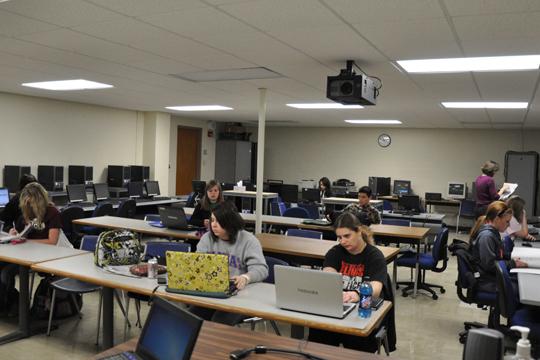Math class embraces 21st century approach
February 16, 2012
Most students have become accustomed to the typical tools needed for your basic math class: calculator, pencil and maybe a protractor or compass.
Technology, as it tends to do, is changing the norm and pushing the way students approach and learn mathematics into the future. An increasing number of classes are moving away from the textbook approach and embracing more progressive ways of learning math.
The use of computers is becoming more widespread in universities across the country, and Washburn is no exception to these changes.
Starting in the fall of 2009, Sarah Cook, Washburn University professor, began making use of computers for her “developmental” algebra classes – classes intended to bring students’ skill level up to college algebra standards – and soon noticed an improvement in final exam scores and an increase in overall passing rates.
The program started as a research idea of Cook’s, who then traveled to Emporia State University and Northwest Missouri State University, who had similar programs in place, and attended several conferences where other universities gave presentations on the benefits of computer use in math labs. From there, Cook customized the program to fit the needs of Washburn University students and added a supply of netbooks to the limited number of personal computers in the computer lab, paid for from the university’s general technology fund, in order to boost class sizes and to prevent unexpected system crashes from hindering student involvement.
“You know how technology works,” said Cook. “We went for a number of years with only 20 computers in the lab and had an enrollment of 20. That always made me really nervous because you’re going to walk in one day and one computer might not work. This allowed us to boost enrollment and gave us a bit of a fail safe as well.”
For a generation of students raised with computers as the centerpiece of daily life, bringing them into a math class seems only natural.
“That is one of the ideas,” said Cook, “[We’re trying] to hit kids with something they’re more comfortable with and used to using.”
Of course, creature comforts aren’t the only reason Washburn has implemented this program. Cook stressed the benefits from this approach.
“The idea is to have more hands on practice,” said Cook. “You learn math by doing math. We have found that, no matter how much homework we assign, the student may not do it or they might get a tutor to help them, and they aren’t getting the full benefit out of the problems that we want them to have. The other benefit is the computerized systems give immediate feedback on whether you’re right or wrong, and you get a chance to redo problems if you didn’t get it right. If the student continues to miss the problem, the computer system will tell the student the correct answer and then generate a new problem for the student to do instead. It can also give you hints on how to do the problem or refer you to a passage in the book that might help.”
Currently, Cook is only using computers in her college algebra class that meets three days a week. On Monday and Wednesdays, the course meets in a traditional classroom setting and works from a textbook. Each Friday, Cook moves her class to the lab where students are able to make use of the computers.
“Students work at their own pace in the labs and have the freedom to select which problems they want to work on that day,” said Cook. “I walk around the lab observing the students’ work and answering any questions the students have. Also, students can access the algebra system through the Internet, and they are expected to work on this outside of the regular class time in addition to the Friday labs.”



